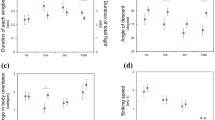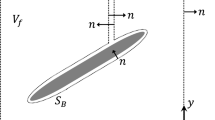Abstract
The formation process of leading-edge vortices has been investigated experimentally using Particle Image Velocimetry. Various airfoil kinematics have been tested, including asymmetric and peak-shifted plunging motions, and are evaluated for Re = 30,000 and a reduced frequency range of 0.2 ≤ k ≤ 0.33. By measuring the growth in the leading-edge vortex during the dynamic-stall process, the vortex pinch-off process is examined based on the concept of an optimal vortex formation time. The various kinematics are then evaluated with respect to their associated vortex strength, timing and convection into the wake.














Similar content being viewed by others
References
Dabiri JO (2009) Optimal vortex formation as a unifying principle in biological propulsion. Ann Rev Fluid Mech (online) 41:17–33
Ellington CP (1999) The novel aerodynamics of insect flight: applications to micro-air vehicles. J Exp Biol 202:3439–3448
Kuessner HG (1936) Zusammenfassender bericht ueber den instationaeren auftrieb von fluegeln. Luftfahrtforschung 13:410–424
Lian Y, Ol MV, Shyy W (2008) Comparative study of pitch-plunge airfoil aerodynamics at transitional reynolds number. 46th AIAA aerospace sciences meeting and exhibit, AIAA-2008-652-812, Reno, USA
McCroskey WJ (1982) Unsteady airfoils. Ann Rev Fluid Mech 14:285–311
Milano M, Gharib M (2005) Uncovering the physics of flapping flat plates with artificial evolution. J Fluid Mech 534:403–409
Mueller TJ, Batill SM (1982) Experimental studies of separation on a two-dimensional airfoil at low reynolds numbers. AIAA Journal 20 No. 4:457–463
Nerger D, Kaehler CJ, Radespiel R (2003) Zeitaufgeloeste piv-messungen an einem schwingenden sd7003-profil bei re=60000. 11 GALA Fachtagung, Braunschweig, Germany
Ohmi K, Coutanceau M, Loc TP, Dulieu A (1990) Vortex formation around an oscillating and translating airfoil at large incidences. J Fluid Mech 211:37–60
Ol MV, McAuliffe BR, Hanff ES, Scholz U, Kaehler C (2005) Comparison of laminar separation bubble measurements on a low reynolds number airfoil in three facilities. 35th AIAA fluid dynamics conference and exhibit, AIAA-2005-5149, Toronto, Canada
Panda J, Zaman KBMQ (1994) Experimental investigation of the flow field on an oscillating airfoil and estimation of lift from wake surveys. J Fluid Mech 265:65–95
Ringuette MJ, Milano M, Gharib M (2007) Role of the tip vortex in the force generation of low-aspect-ratio normal flat plates. J Fluid Mech 581:453–468
Rival D, Tropea C (2009) Characteristics of pitching and plunging airfoils under dynamic-stall conditions. 47th AIAA aerospace sciences meeting and exhibit, AIAA-2009-0537, Orlando, USA
Selig M, Guglielmo J, Broeren A, Giguere P (1995) Summary of low-speed airfoil data. SoarTech Publications, Virginia Beach, USA
Theodorsen T (1935) General theory of aerodynamic instability and the mechanisms of flutter. NACA Report No 496
Thomas ALR, Taylor GK, Srygley RB, Nudds RL, Bomphrey RJ (2004) Dragonfly flight: Free-flight and tethered flow visualizations reveal a diverse array of unsteady lift-generating mechanisms, controlled primarily via angle of attack. J Exp Biol 207:4299–4323
Acknowledgments
The authors would like to thank Dr. Michael Ol from Wright-Patterson AFB for the fruitful discussions regarding Theodorsen’s theory. This research was supported by the Deutsche Forschungsgemeinschaft (DFG) within the national priority program entitled Nature-Inspired Fluid Mechanics (SPP1207).
Author information
Authors and Affiliations
Corresponding author
Rights and permissions
About this article
Cite this article
Rival, D., Prangemeier, T. & Tropea, C. The influence of airfoil kinematics on the formation of leading-edge vortices in bio-inspired flight. Exp Fluids 46, 823–833 (2009). https://doi.org/10.1007/s00348-008-0586-1
Received:
Revised:
Accepted:
Published:
Issue Date:
DOI: https://doi.org/10.1007/s00348-008-0586-1




